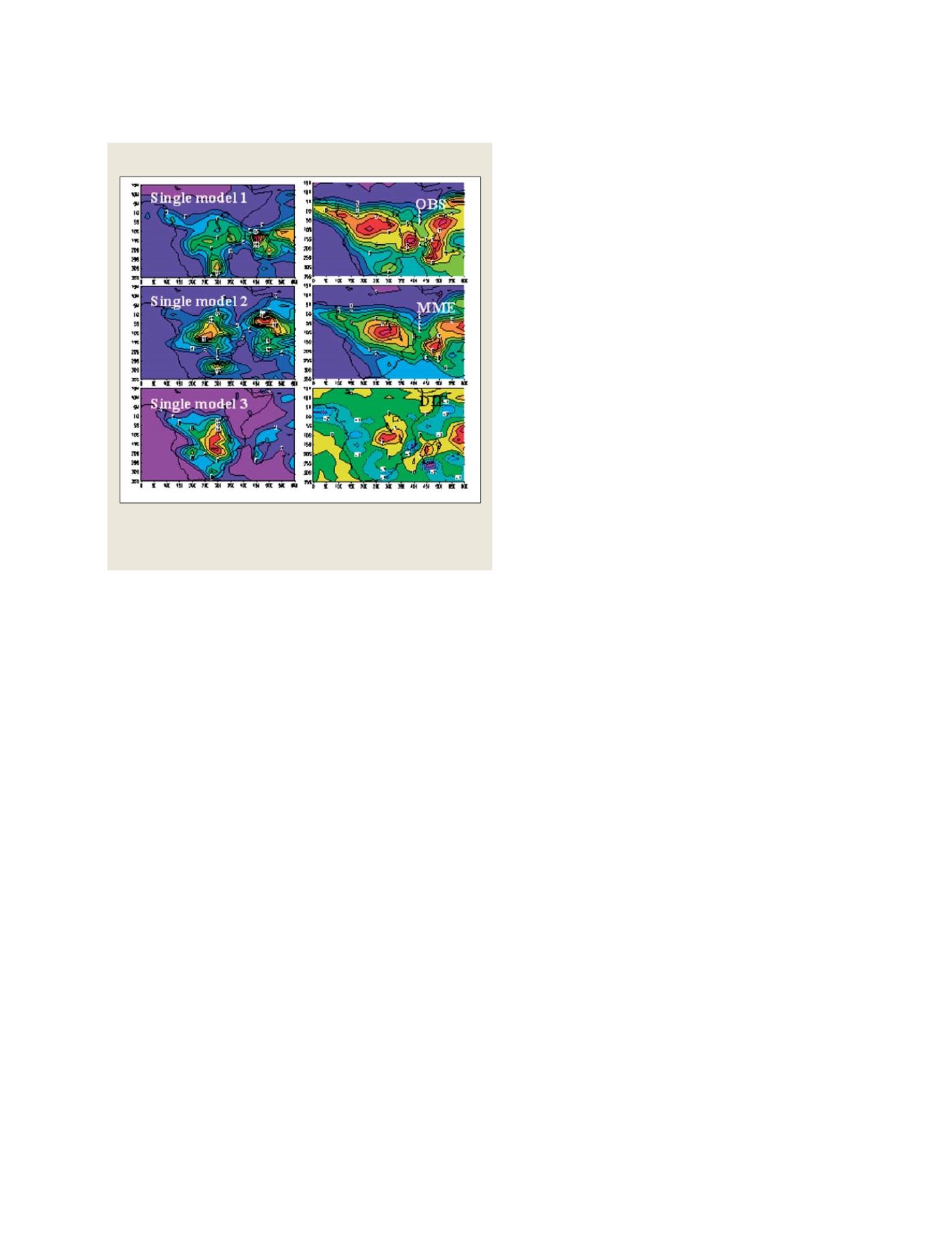

an El Niño and La Niña/climate monitoring system and a long-
range forecast system. Through this project, the El Niño prediction
and a dynamic long-range forecast system has been operating since
1999. Since then, several improvement projects have been carried
out such as a global sea surface temperature forecast model and a
long-range forecast model development. Currently, the systems
operationally carry out monitoring and prediction of global climate,
including El Niño and La Niña, and predicted information and
products are being provided to the WMO and used for WMO press
releases for the El Niño/La Niña Update.
Based on statistical methods, KMA started to issue a monthly
long-range forecast in 1973, a cold and warm seasonal three-month
long-range forecast from 1984, and four seasonal forecasts from
1991. The dynamic long-range forecast system has been operating
since September 1999 using a global long-range forecast model,
Global Data Assimilation and Prediction System (GDAPS
T106L21), which was developed through aforementioned projects.
Currently KMA produces three types of dynamic long-range fore-
casts: one-month, three-month, and six-month forecast. The
one-month forecasts are issued three times a month, consisting of
temperature, precipitation and air pressure patterns for the next
30 days. The three-month forecasts, which are produced on a
monthly basis, consist of temperature and precipitation trends
including special seasonal events such as Asian dust, Typhoon and
Changma (rainy season over Korea) for the next three months. The
six-month forecast is issued twice a year (May and November).
Those results and activities are presented and discussed at the Joint
Meeting on Seasonal Prediction of the East Asian Monsoon, in
which the East Asian countries participate.
The effort to improve climate prediction techniques
was also realized in the establishment of the APEC
Climate Center (APCC), which was set up in Busan,
the Republic of Korea in November 2005, with a view
to enhancing the capacity of monitoring and predict-
ing unusual weather and climate changes in the
Asia-Pacific region. The basic principle in the opera-
tion of APCC is to share optimized and high-cost
climate information and products with the participat-
ing organizations from APEC member economies. The
APCC tries to realize the APEC vision of regional pros-
perity through the enhancement of economic
opportunities, the reduction of economic loss, and the
protection of life and property by responding effec-
tively to natural disasters and mitigating economic
losses in the case of extreme climate events. The APCC
contributes to the enhancement the socio-economic
well-being of APEC member economies by utilizing
up-to-date scientific knowledge and applying innova-
tive climate prediction techniques. APCC, which was
also registered as a modelling and data processing
centre for the Global Earth Observation System of
Systems (GEOSS), has processed and disseminated
operational climate prediction information and prod-
ucts based on the multi-model ensemble (MME)
technique to all member economies APCC carries out
sensitivity studies of various individual models and the
APCC-MME system to surface boundary forcing. In
this connection, a statistical downscaling using MME
products is developed and implemented for the esti-
mation of rainfall over the Korean peninsula and other
regions. Examinations of predictability of specific
phenomena, such as the El Niño-Southern Oscillation
(ENSO), Pacific/North American pattern (PNA), trop-
ical cyclone activity, intra-seasonal variations of
monsoon prediction, Asian dust, and extreme climate
events are also being carried out.
With the above experiences in the area of climate
monitoring and prediction, KMA has recently served
as one of nine WMO Global Producing Centres (GPCs)
for long-range forecasts (LRF) since November 2006.
1
Recently, KMA began to distribute long-range forecast
data to other GPCs and WMO member countries
through the website.
2
The further development of
advanced prediction schemes for long-range forecasts
is now a current task of KMA. KMA is operationally
using the MME techniques, which has been proved to
be a leading-edge technology to make up for the
systematic errors of each single model. A comparison
of single model results and multi-model ensemble
prediction indicates that MME results are superior to
the individual models. With recognition of this expe-
rience, KMA will also work as a collector of global LRF
data provided by other GPCs. Such prediction data will
be standardized and disseminated to other GPCs and
Regional Climate Centers (RCCs).
The provision and sharing of technical information
and techniques about MME is important for users to
pursue LRF MME predictions. In this connection, KMA
[
] 213
Single model vs. multi-model ensemble
MME techniques, which has been proved to be a leading-edge technology in
compensating for the systematic errors of each single model. Here, single model
results are compared with multi-model ensemble predictions
Source: Won-Tae Yun, Florida State University (FSU) Multi Model Superensemble
Prediction system, The Second Regional Climate Modeling Workshop for the Greater
Horn of Africa, DMC Nairobi, Kenya, February 2004
S
OCIETAL
B
ENEFIT
A
REAS
– C
LIMATE
















